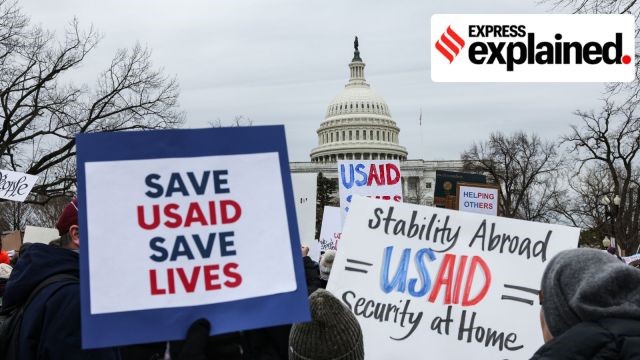USAID Funding in India

- 11 Mar 2025
In News:
The United States Agency for International Development (USAID) has been a major development partner for India, contributing over $2.8 billion in Official Development Assistance (ODA) since 2001. While initial assistance focused on food aid, recent decades saw a shift toward public health, environmental sustainability, digital infrastructure, and institutional capacity building.
Between 2022 and 2024, India received substantial aid from USAID — $228 million in 2022, $175 million in 2023, and $151 million in 2024 (as of December). A significant portion of this funding targeted health and population programs, including polio eradication, maternal and child health, tuberculosis (TB), HIV/AIDS, and Covid-19 response.
In 2022 alone, $120 million was allocated to Covid-19 control, alongside support for healthcare infrastructure and awareness campaigns.
USAID also supported India’s environmental goals, providing funds for air pollution control, clean water initiatives, and climate resilience, with $17.12 million allocated in 2024. Additionally, USAID backed India's technological advancement by exploring secure 5G Open Radio Access Network (O-RAN) systems, aligning with the U.S. Indo-Pacific strategy aimed at countering China’s influence.
However, the January 20, 2025 Executive Order by the U.S. administration directed a halt to foreign aid and restructuring of USAID. Although initially stayed by a U.S. Federal Court in February, the Supreme Court’s March 5 verdict upheld the aid cuts, jeopardizing thousands of ongoing development projects globally, including in India.
This decision critically affects India’s public health landscape. For instance, the ‘Breaking the Barriers’ TB awareness program in Karnataka, Bihar, Telangana, and Assam — funded with $7 million between 2022–23 — is being discontinued. The President’s Emergency Plan for AIDS Relief (PEPFAR), another major source of HIV/AIDS support, also faces disruption, risking higher infection and mortality rates. The cuts particularly threaten NGOs like Karnataka Health Promotion Trust (KHPT), which relied on USAID for operational continuity.
Beyond health, the withdrawal of USAID support may create a strategic vacuum in South Asia, enabling greater Chinese geopolitical and economic influence. Legal uncertainty around development aid has also raised concerns about the stability of global health and environmental partnerships.
Way Forward for India
- Diversify donor engagement: India must strengthen development ties with consistent partners like Japan ($2.97B in 2022), the EU ($383.5M), and Germany ($235M).
- Increase domestic investments in public health, sanitation, and clean energy to reduce dependence on external aid.
- Boost private sector and philanthropic partnerships to ensure continuity of key health and environmental programs.
- Strengthen indigenous R&D capacity, especially in digital infrastructure and vaccine development.
- Diplomatic dialogue with U.S. policymakers can explore possibilities for reinstating targeted support.
Conclusion
The scaling back of USAID poses significant challenges to India's public health, environmental sustainability, and strategic autonomy. However, it also presents an opportunity for India to reinforce its developmental sovereignty through diversified funding, innovation, and international cooperation.
